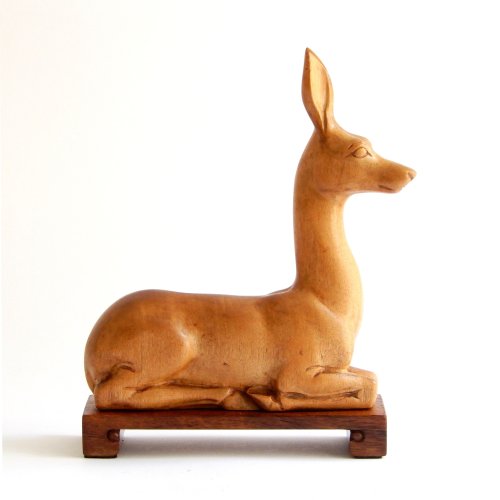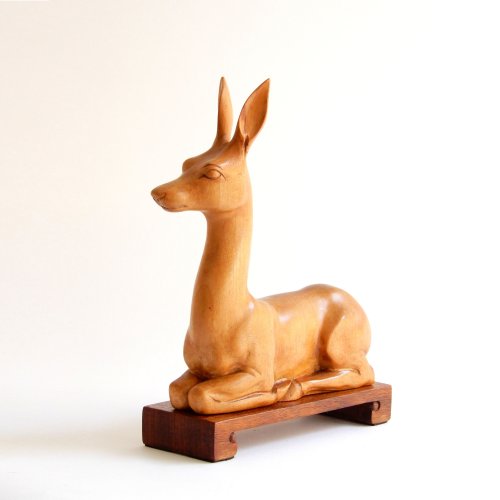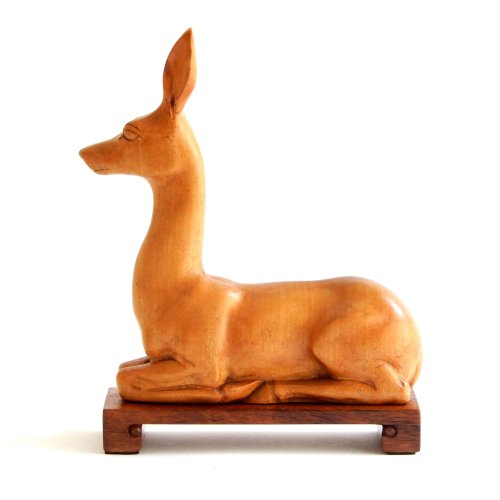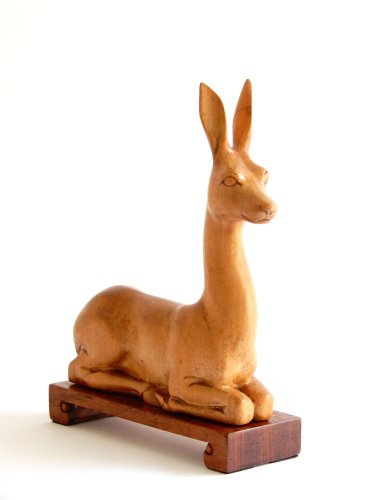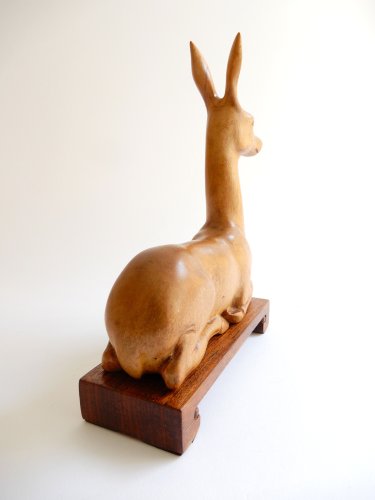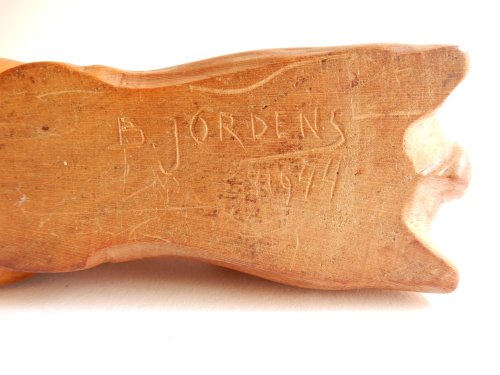Barend Jordens (1888-1972) Reclining deer
About this piece
A graceful reclining deer, carved from European cherry wood by the Dutch sculptor Barend Jordens in 1944. The deer was carved while Barend Jordens was in hiding on the Frankendael estate. He was there with the art dealer Jack Vecht, who received this deer as a gift from Jordens. Jack Vecht owned the deer until his death. It was then sold to the previous owner.
Jordens probably carved this deer from memory and was not able to study it properly, it is not entirely correct anatomically, for example, the ears are a bit longer than usual. However, the deer is beautiful, elegant, graceful and it is like seeing a deer lying in a forest that can suddenly jump away if it hears you. A beautiful moment captured in time. I also like that the deer is lying in an unusual position, with his legs folded under him. Deer are a rewarding subject for many artists, but I have never seen them in this position before.
The base, which is carved from rosewood, is also graceful and as elegant as the deer.
The deer is signed on the bottom with "B. Jordens, 1944".
Biography:
Barend Jordens (Amsterdam, Dec. 17, 1888 – April 3, 1972), sculptor, watercolourist, ceramist, glass designer, monumental artist, furniture designer, in short, an all-rounder, as was not unusual at that time.
Barend Jordens was educated at the Teekenschool voor Kunstambachten in Amsterdam from 1904 to 1908. He was a student of Oosschot. In 1919 he became a teacher at the Quellinus Kunstambachten- en Teekenschool ( School for drawing and applied arts). He taught modelling and woodcarving.
Barend Jordens was best known as a sculptor. He mainly worked in wood and bronze.
He made ornaments for furniture and worked for De Bazel and Lauweriks, among others. Jordens also made architectural sculptures, such as the sculptural elements on the facade of Tuschinski from 1919-1921. In 1956 he also designed stained glass windows.
In addition to his work at the academy and for projects, he also exhibited. He exhibited his work at the famous World Exhibition Arts Décoratifs in Paris in 1925. He was awarded with a silver medal there for his work.
He exhibited in the Stedelijk Museum in Amsterdam in 1925, together with Piet van Wijngaerdt.
Jordens first worked in the Amsterdam School style, later his style became more expressionistic, after which his work became increasingly stylized. Later, at the end of the 1930s, his style became more naturalistic again. This deer is a good example of that.
Literature:
- Titus M. Eliëns, Marjan Groot, Frans Leidelmeijer; 'Arts and crafts in the Netherlands, 1880-1940', V+K Publishing / Inmerc, 1997, Bussum. P. 223.
- Rein Stuurman & Janny Stuurman-Aalbers; 'What are sculptures worth', Scriptum Art, Schiedam, Netherlands, 2014. P. 54.
- Rob Zeegers, Janny Stuurman-Aalbers, Reinold Stuurman; Scriptum Art, Schiedam, NL & Snoeck-Decaju & Son, Gent, Belgium, 2000. p.169.
Condition
The left ear is professionally restored.
Material:
Wood
Measurements:
Deer:
Length: 19 cm
(7,48")
Width: 5 cm
(1,97")
Height: 19,5 cm
(7,68")
Base:
Length: 16,2 cm
(6,38")
Width: 6 cm
(2,36")
Height: 2,3 cm
(91")
Year:
1944
Origin:
the Netherlands
Artist / atelier:
Barend Jordens,
